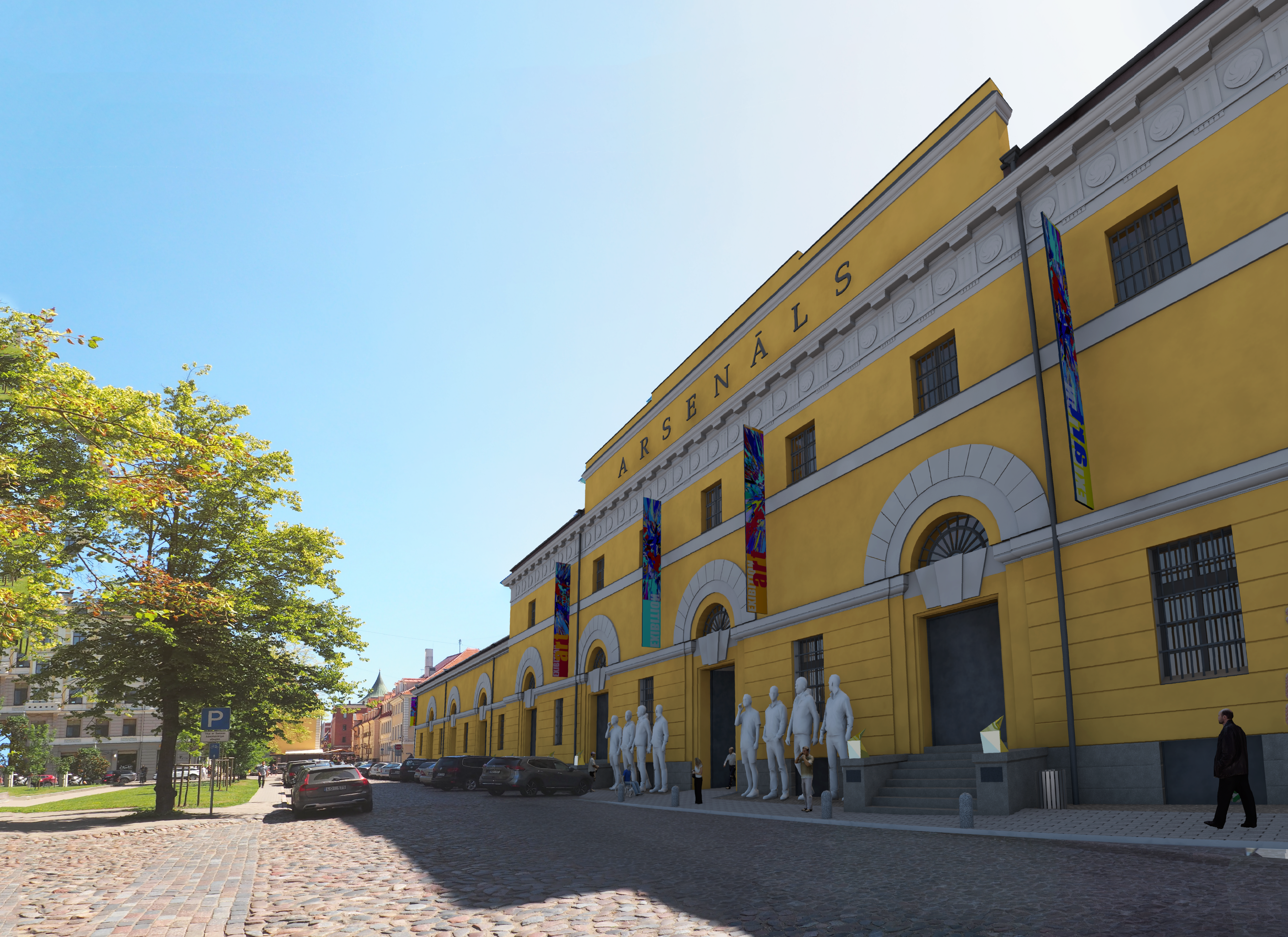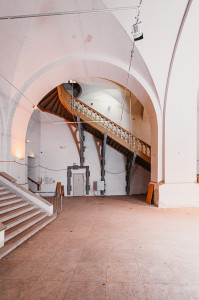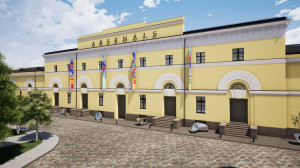









The project implementation consists two stages. The first stage was completed in May 2022, and it included the development of a construction design for the rebuilding and restoration of the property at Torņa iela 1 in Riga, which underwent an expert review. Also, as part of this work, the facade was restored, the foundation was waterproofed, and the windows were replaced. Given the current situation and the disproportionately high costs of construction, it was decided to raise European Union funding to implement the second stage of the project during the 2021–2027 planning period. According to the above draft Cabinet Regulations, the financing for the construction is to come both from the ERDF and from the national budget. The building is historical and, therefore, has high levels of primary energy consumption. The developed construction design includes the installation of a forced ventilation system with heat recovery units, as well as air conditioning that meets the requirements for the storage of works of art and the well-being of workers. The project also involves a complete reconstruction of the building’s interiors as well as HVAC, power, telecoms, and water and sewer systems in order to meet modern safety and general requirements. It is also planned to improve energy performance, insulating and replacing the roof, and rebuilding the section of Torņa street between Jēkaba and Arsenāla streets with the construction a rainwater drainage system within it, in order to solve the issue of high ground water levels around the property and the seepage of water into its basement.
The Arsenāls exhibition hall of the Latvian National Museum of Art is located in an important architectural heritage site, a late Russian-classicist customs warehouse or arsenal building from the early 19th century, which has been adapted for museum use. The building was originally designed by architect Johann Eduard de Witte. A little later, the design was expanded with suggestions by Julius Adolph Spazier; in 1828, St Petersburg architect Alexander Nellinger and customs department architect Ivan Lucchini prepared the final version, and in November 1832, the official commissioning of the building took place.
The arsenal building was used as a warehouse throughout its history. It the 1920–30’s, it accommodated the personal belongings of members of the military. After the Second World War, a department of the Soviet Army used it for storing goods and supplies; it was also used by a military school. In the mid-1980’s, the building was taken over by the Ministry of Culture, which arranged for the creation of a museum there. On 1 January 1989, after the relocation of the the second half of the 20th century art collection from a building in Krišjāņa Valdemāra street, the Arsenāls art museum opened its doors.
In accordance with the Cabinet Order of 20 December 2000, the Association of Art Museums of Latvia was dissolved, reorganising the entire structure of the National Art Museum and the Arsenāls art museum at the same time. A single national museum was created on the basis of these two museums: the National Museum of Art. On 1 September 2005, the museum was renamed the Latvian National Museum of Art, but Arsenāls has continued to function as an exhibition hall for LNMA.
On 24 February 2020, the exhibition hall shut down for renovation. The goal of the reconstruction is to restore and preserve the building, with the restoration of the facade, repairs of the roof eaves, waterproofing of the foundation, restoration of the basement hatches and windows, adaptation of the interiors in order to create a modern venue for the exhibition of art and public events.[1] Before the beginning of the reconstruction, some of the LNMA collection that had been in the Arsenāls building was moved to the Museum Repository at Pulka iela 8 in Riga, where it will remain.
The Latvian National Museum of Art is looking forward to further development of this project that is of long-term significance and impact, and goes beyond the limits of a single institution. After reconstruction, Arsenāls has the potential of becoming the largest art exhibition venue in Riga where the museum will implement programmes related to both the study of the recent artistic heritage and the current trends in contemporary art, while also making room for large and prestigious international shows. Respecting the principles of good governance and inclusive society, the new cultural space will serve the community, inviting everyone to discover and experience art, creativity, and openness to diversity.
Māra Lāce
LNMA Director











The purpose of the project:
Activity 5.1.1.5 ‘Renovation of unique European cultural heritage to improve its accessibility and develop cultural services’ of Specific Assistance Goal 5.1.1 ‘Work towards integrated social, economic, and environmental development, and improvement in cultural heritage, tourism, and security in local areas’ of the EU Cohesion Policy Programme for 2021–2027.
The purpose of the activity is to preserve, protect, and develop unique national cultural heritage sites located within the UNESCO World Heritage Site of the Historic Centre of Riga, improving the accessibility of the sites and expanding their innovative use as sustainable resources for improving the quality of human life and strengthening the local community.
21.02.2024. Noslēdzies 28.12.2023. iepirkums Nr. VNĪ 2023/7/2-8/AK-90 ar 2 pretendentu piedāvājumiem.
29.02.2024. Izstrādāta Izmaksu un ieguvumu analīze.
29.02.2024. KPVIS sagatavots projekta pieteikums 5.1.1.5/1/24/I/001 “Izstāžu zāles Arsenāls pārbūves un restaurācijas darbu veikšana II posms”.
24.04.2024. Izvērtēts 28.12.2023. iepirkums Nr. VNĪ 2023/7/2-8/AK-90, ņemot vērā rezultātu, tas ir pārtraukts.
Saņemti CFLA pirmie komentāri par projekta iesniegumu.
Tiek gatavota dokumentācija atkārtotam iepirkumam, ņemot vērā pretendentu iepirkuma jautājumus un CFLA komentārus.
24.05.2024. KPVIS iesniegts projekta iesniegums ar precizējumiem.
22.05.2024. Izsludināts atkārtots iepirkums (ID Nr. VNĪ 2024/7/2-8/AK-44). Piedāvājumu iesniegšanas termiņš – 15.07.2024.
12.06.2024. saņemti IIA precizējumi, nepieciešams iesniegt projekta budžetu, kad Rīgas valstspilsēta varēs formulēt savu finansējuma daļu.
13.06.2024. norisinājās tikšanās ar Rīgas domes pārstāvjiem par CFLA nosacījumiem projekta apstiprināšanā.
26.06.2024. saņemti papildinājumi no LNMM CFLA projekta pieteikumam par Bauhaus prasībām.
03.07.2024. saņemts pozitīvs IUB atzinums par AK "Būvprojekta izmaiņu izstrāde un būvprojekta izstrāde 3D BIM vidē, autoruzraudzība, BIM aktualizācija būvdarbu laikā un būvdarbi Torņa ielā 1, Rīgā” (ID Nr. VNĪ 2024/7/2-8/AK-44)” nolikumu.
15.07.2024. atvērti iepirkuma Nr. VNĪ 2024/7/2-8/AK-44 piedāvājumi, uzsākta vērtēšana.
19.07.2024. izvērtēta pretendentu piedāvājumu BIM atbilstība.
22.07.2024. saņemts sadarbības partnera parakstīts Apliecinājums par informētību attiecībā uz interešu konflikta jautājumu regulējumu un to integrāciju iekšējās kontroles sistēmās.
24.07.2024. norisinājās tikšanās ar CFLA un Rīgas valstspilsētas pašvaldības pārstāvjiem par Sadarbības līguma grozījumiem.
26.07.2024. saņemts sertificēta būvinženiera atzinums, ka projekta ietvaros veicot plānotos ieguldījumus noteiktās teritorijās, nav iespējams izvairīties no infrastruktūras bojāšanās.
14.08.2024. nosūtīta vēstule CFLA ar lūgumu pagarināt projekta iesnieguma termiņu līdz 15.09.2024.
20.08.2024. norisinājās valdes sēde, kuras laikā lemts par priekšfinansējuma piešķiršanu projekta īstenošanai t.sk. RD daļā.
23.08.2024. norisinājās tikšanās ar RD ĀMD, kuras laikā departaments paziņoja, ka nevar parakstīt Sadarbības līgumu pirms RD lēmuma, nākamā RD sēde septembrī, līdz ar ko ir nepieciešams CFLA projekta iesnieguma pagarinājums vismaz līdz oktobra beigām, 28.08.2024. nosūtīta vēstule CFLA ar lūgumu pagarināt iesnieguma iesniegšanas termiņu līdz 30.10.2024.
18.09.2024. norisinājās Rīgas domes sēde, kurā atbalstīts lēmums par sadarbību projektā "Izstāžu zāles Arsenāls pārbūves un restaurācijas darbu veikšana II posms".
24.09.2024. norisinājās ārkārtas Valdes sēde, kurā lemts iesniegt ziņojumu padomes iepriekšējas piekrišanas saņemšanai līguma noslēgšanai ar atklāta konkursa "Būvprojekta izmaiņu izstrāde un būvprojekta izstrāde 3D BIM vidē, autoruzraudzība, BIM aktualizācija būvdarbu laikā un būvdarbi Torņa ielā 1, Rīgā " (ID Nr. VNĪ 2024/7/2-8/AK-44) uzvarētāju PS “P un S BŪVNIECĪBA” par summu 16 491 128,68 EUR ar PVN.
27.09.2024. norisinājās VNĪ Padomes sēde, kurā saņemta iepriekšēja piekrišana līguma noslēgšanai ar PS "P un S Būvniecība".
25.10.2024. saņemta precizēta Izmaksu un ieguvumu analīze, pievienota KP VIS.
29.10.2024. iesniegts precizēts projekta iesniegums KP VIS.
07.11.2024. norisinājās programmas atklāšanas pasākums kopā ar Eiropas komisiju Arsenāla telpās.
22.11.2024. parakstīts projektē-būvē līgums ar PS "P un S Būvniecība", izpildes termiņš 36 mēneši.
03.12.2024. norisinājās tikšanās ar būvnieku PS "P un S Būvniecība", LNMM un KM par līguma nosacījumiem.
20.12.2024. izvesti bīstamie atkritumi no objekta.
02.01.2025. parakstīts CFLA projekta līgums Nr. IEN/2024/1810.
02.01.2025. parakstīts Sadarbības līgums ar LNMM.
09.01.2025. veikta ģeodēziskā uzmērīšana.
14.01.2025. no CFLA puses apstiprināts Avansa maksājums Nr.1.
17.01.2025. parakstīts Objekta P-N akts Nr. A/2025/405.
30.01.2025. VNĪ būvuzraugs un Darba aizsardzības speciālists pieņēma iekārtoto būvlaukumu, sastādīti akti par pārkāpumiem.
03.02.2025. parakstīta Darbu veikšanas programma.
05.02.2025. parakstīta Monitoringa programma.
14.02.2025. VNĪ darba aizsardzības speciālists instruē būvuzņēmēja darbiniekus par darba drošību objektā.
22.02.2025. iesniegti 3D BIM modeļi Morpho un saņemta būvuzņēmēja vēstule par projektēšanas 1. posma pabeigšanu.
07.03.2025. NKMP veica objekta apsekošanu.
18.03.2025. parakstīts Atgūtā būvmateriāla nodošanas- pieņemšanas akts (dolomīta plāksnes, kas nogādātas Rīgas pilī).
22.03.2025. Morpho ielādēti projektēšanas 2.posma nodevumi.
24.03.2025. BVKB veica pārbaudi objektā.
28.03.2025. parakstīta vienošanās par Atsevišķo darbu pielīgšanu bez teritorijas labiekārtošanas darbiem.
28.03.2025. uzstādīts Projekta informatīvais stends.
30.04.2025. Morpho vidē ielādēti projektēšanas 2. posma nodevumi.
Grīdu demontāžas laikā atklājušās vēsturiskās kaļķakmens plāksnes aptuveni 500 m2 apmērā, kuras pēc NKMP norādēm ir uzglabājamas objektā.
Sienu un griestu demontāžas laikā atklājušās plaisas, kuru novēršanas risinājumam nepieciešams veikt ekspertīzi.
Izmaiņu būvprojekta izstrādes laikā secināts, ka esošā elektropieslēguma jauda ir nepietiekama.
11.06.2025. saņemta Saeimas Administrācijas atļauja būvdarbu uzsākšanai Saeimas aizsargjoslā.
Objektā bija NKMP novērtēt jaunatklātās vēsturiskās plāksnes, uzstādījums ir tās uzglabāt un izmantot pēc iespējas atkārtoti.
Noslēgusies CA ekspertīzes veikšanai BK daļai- plaisas, 30.06.2025. parakstīts ekspertīzes līgums.
Veikts BK konstruktora ieraksts BIS, kādi darbi ir atļauti pirms plaisu novēršanas.
18.07.2025. parakstīti līguma grozījumi Nr. IZD/2024/1438-2 par projektēšanas termiņa pagarinājumu.
24.07.2025. iesniegta NKMP Kaļķakmens plākšņu inventarizācija.
24.07.2025. Objektā pārbaudi veic BVKB. 01.08.2025. saņemts BVKB atzinums, par objektā veiktajiem darbiem aizrādījumu nav, bet lūdz novērst Arsenāla ielas bruģa iebrukumu, kas ir ārpus BP robežas.
Demontējot jumtu, tika konstatēta trupe jumta spārēs, 20.08.2025. BISā ievietots risinājums jumta spāru protezēšanai, būvuzņēmējs apzina papildu darbu izmaksas.
21.08.2025. TAP ir ievietots tiesību akts “Par apropriācijas pārdali no Finanšu ministrijas budžeta apakšprogrammas uz Kultūras ministrijas budžeta apakšprogrammu”.
Šobrīd tiek veikti LKT tīklu izbūves darbi iekšpagalmā, jumta demontāžas darbi un starpsienu izbūves darbi.
Informācija atjaunota: 01.09.2025.


-thumbnail.jpg)
-thumbnail.jpg)
